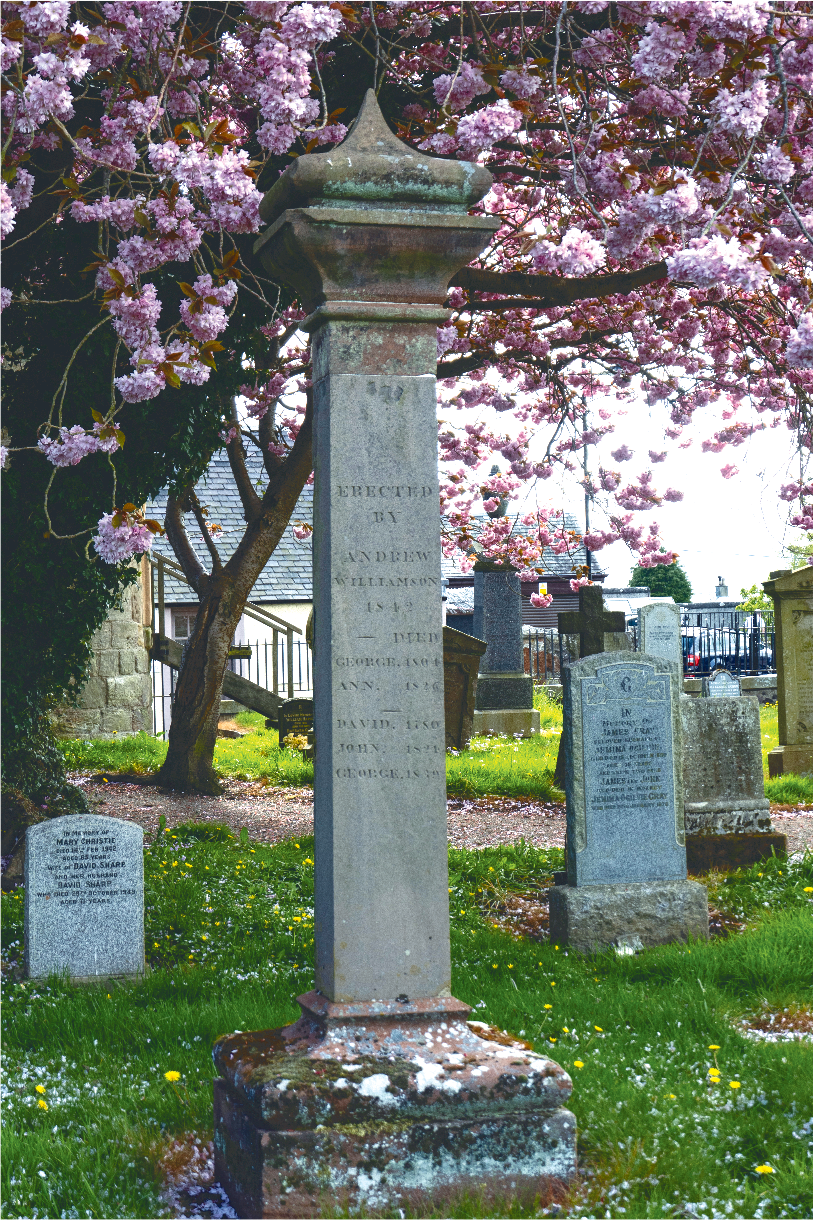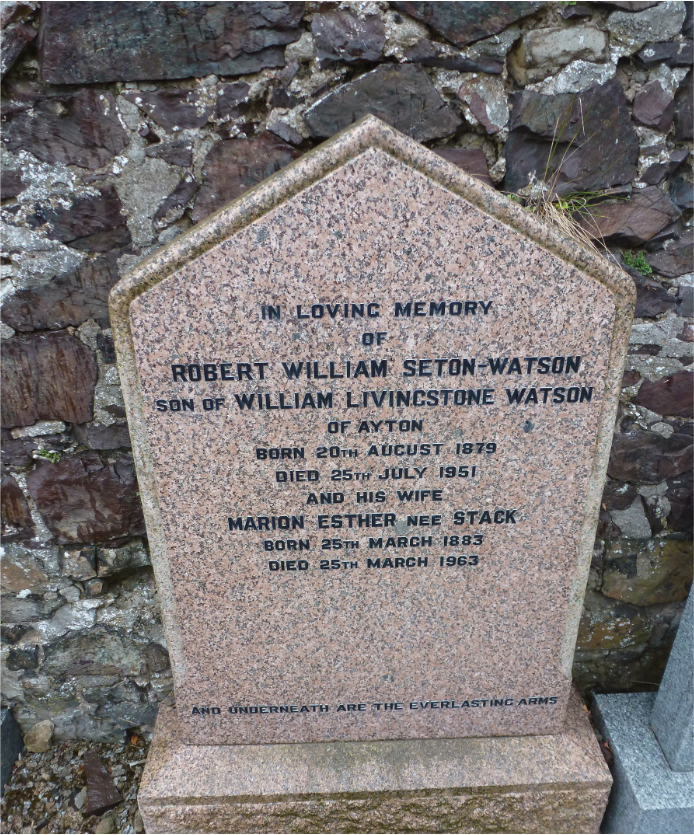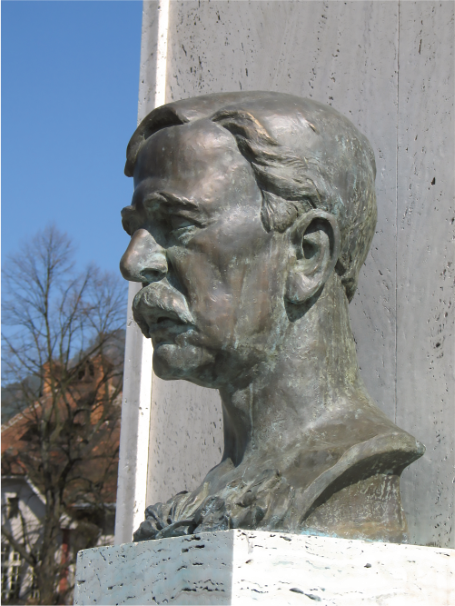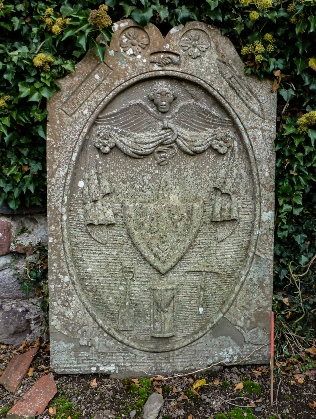
Last date for submissions
31st October 2022Date of publication
1st December 2022


WHO IS IN YOUR GRAVEYARD?
I find graveyards very interesting places, a place for family research, a place for a history lesson and not a place to be afraid of. My granny told me “It’s the living you have to be afraid of and not the dead”, so give the one in the middle of our village, next to the church, a visit sometime and you are sure to find some interesting grave stones.
I hope this regular article will give you an insight into some of the very interesting people buried in the graveyard and a bit of history behind that person or those persons. I intend to leave a marker beside the gravestone in question so that you can check it out for yourself.
The Robertson Brothers and the Tay Bridge Disaster.
The Tay Bridge Disaster happened one very stormy night on the 28th December 1879 just after 7 o’clock killing all on board. The train was travelling from Burntisland to Dundee when the bridge collapsed throwing steam engine, carriages and all the passengers and crew into the freezing water of the river Tay.
Two of the passengers on that stormy night were the Robertson brothers from Abernethy, William aged 21 and Alexander aged 22. The brothers were single and lived with their father at Main Street, Abernethy, but at that time were living in digs at 100, Foundry Lane, Dundee. Both were employed as stokers in a gas works in the city.
It was a stormy night when the brothers boarded the train at Abernethy station, hoping to make the connection at Ladybank station with the ill fated train travelling from Burntisland. William was dressed in dark tweed suit, woollen shirt and striped blue and grey socks while Alexander with his dark hair, large whiskers and moustache wore a dark cloth overcoat, light tweed suit, Rob Roy tartan scarf and silver lever watch. We know all this information because as the bodies were recovered great care was taken to detail each individual.
Unfortunately, they did make the connection at Ladybank and the rest is history.
Jimmy Swan
WHO IS IN YOUR GRAVEYARD? 2
If you went to check out the Robertson brothers’ grave I hope you found it, and I will use the same orange marker again this time.
The name Williamson will be familiar to many in the village, yes the Williamson Hall. But who was Williamson? The man in question was Andrew Williamson, one of the Williamsons who farmed Mid and Easter Clunie and Skirlbear.
Andrew worked as a school teacher in Kirkcaldy and met his wife Margaret Scott there.
The Willaimsons were, as you say, well connected and owned much land and property in the area. They were kirk goers and were members of the U.P. Kirk, the one in Kirk Wynd presently owned by Mr and Mrs Smith, Kirkland Restoration.
Presumably Andrew came up with the idea of a public hall to be used for the betterment of the population of the village and surrounding area. Andrew donated £50 6s 5d, to start a fund to raise the money needed to build the hall. Under the control of the U.P. Kirk, £5 was added annually from 1843 to 1880 until enough was in the coffers to enable the work to begin. The total cost of the hall was £420 17s, (£50,857. 68p in today’s money).
The hall was opened on the 11th October 1880, but unfortunately Andrew never saw it as he died in 1846.
It was dedicated to him with the grand title of The Williamsonian Scientific Hall and Library, better known to us as the Willi Hall.
In the early days it had a library, and a further fund was set up to purchase books for it as well as the many functions held in the main hall.
The Williamson Hall is still a favourite venue for all sorts of functions, weddings, craft fairs, Burns suppers and many more.
 As you can see from the photo below the family grave stone is a tall majestic one and stands head and shoulders above the stones surrounding it. To find it easily enter the graveyard by the main gate, bear right, and look for the orange marker.
As you can see from the photo below the family grave stone is a tall majestic one and stands head and shoulders above the stones surrounding it. To find it easily enter the graveyard by the main gate, bear right, and look for the orange marker.
Jimmy Swan
WHO IS IN YOUR GRAVEYARD? 3
Robert William Seton-Watson (FBA FRHistS) born 1879 died1951

 His bust at Ruzomberok City Hall in Slovakia
His bust at Ruzomberok City Hall in Slovakia
Like many, you may not have heard of Professor Robert William Seton-Watson but his contribution to the study of Scottish history and his links with European neighbours, in particular Slovakia, are well known. Born in London in 1879 to well to do Scottish parents and educated at Winchester and New College, Oxford, Seton-Watson was fluent in French, German and Italian.
After graduation, Seton-Watson travelled to Berlin University, the Sorbonne and Vienna University, from where he wrote a number of articles on Hungary for The Spectator. His research for these articles took him to Hungary in 1906, and his discoveries there turned his sympathies against Hungary and in favour of then subjected Slovaks, Romanians, and the Southern Slavs. He learned Hungarian, Serbian and Czech, and, in 1908, he published his first major work, Racial Problems in Hungary.
Seton-Watson became friends with the Vienna correspondent of The Times, Henry Wickham Steed and the Czechoslovak philosopher and politician Tomáš Masaryk. He argued in books and articles for a federal solution to the problems of the Austro-Hungarian Empire, then riven by the tensions between its ancient dynastic model and the forces of ethnic nationalism.
Seton-Watson was champion of the rights of small nations, and before the Great War many small nations of Europe which we see today as successful independent states were controlled by large Empires ruled over by interbred Royal families. The Serbians, or indeed the many other nations under the control of the Habsburg Empire, desired self determination for their countries.
During World War 1 he was Secretary of the Serbian Relief Fund and was politically active promoting the rights of the Czechs and the Slavs. He was disapproved of by the UK government and he was put to work, in 1917, in the Royal Army Medical Corps scrubbing hospital floors. Others, however, rescued him, and from 1917 to 1918 he served on the Intelligence Bureau of the War Cabinet in the Enemy Propaganda Department, where he was responsible for British propaganda to the peoples of the Austro-Hungarian Empire. He assisted in the preparations for the Rome Congress of subject Habsburg peoples, held in April 1918.
Following the end of the War, Seton-Watson attended the Paris Peace Conference, 1919 in a private capacity, advising the representatives there of formerly subject peoples. Although on bad terms with the governments of the major powers, whom he famously referred to as "the pygmies of Paris", he contributed to discussions of where the new frontiers of Europe should be and was especially influential in setting the postwar frontiers between Italy and the new state of Yugoslavia.
Although the British Government was unenthusiastic about Seton-Watson, other governments were not, showing their gratitude after the conference. Masaryk became the first president of the new state of Czechoslovakia and welcomed him there. His friendship with Edvard Beneš, now Czechoslovakia's foreign minister, was consolidated. Seton-Watson was made an honorary citizen of Cluj in Transylvania, which had been incorporated into Romania despite the claims of Hungary and, in 1920, it was formally acclaimed by the Romanian parliament. Yugoslavia rewarded him with an honorary degree from the University of Zagreb.
He attended the opening ceremony of the Abernethy War Memorial 100 years ago and gave an impressive speech on that day.
He died in 1951 on the Isle of Skye where he had retired but is buried here in Abernethy in the old graveyard in one of the central walled areas alongside other family members.
Although he is not known by many here he is well known by many in Slovakia.
Jimmy Swan (look out for the stick with the pink paint)
WHO IS IN YOUR GRAVEYARD? 4

The vast majority of gravestones in our graveyards have a fairly detailed inscription of the deceased and possibly other family members. However, if you look hard enough you might find tucked away in a corner, and probably covered in ivy, an example of a stone from a bygone age when the stone consisted of mainly symbols, but if you are very lucky there may be a name or even a set of initials to help you identify the deceased.
One against the east wall of our graveyard and another lying flat near the vestry door are two examples of such stones. I will use the one against the east wall as it is easier to decipher, the one lying flat is partly covered with soil. For those of you who don’t know east from west, the east wall is the one nearest the Cree’s Inn.
This particular stone has the initials “J Y”, and with no other information it is very difficult if not impossible to identify the person or persons interred.
From the symbols you can tell many things: occupation, marital status and whether it was a child. In this case I am sure it was an adult. From the photograph you can see a number of very clear symbols.
Starting at the top is the clasped hands symbol. Often two hands are clasped in a final farewell, especially on the tombs of married couples.
As on many gravestones of this age the stone is dominated by the winged head, popular especially in the 17th and 18th centuries, it signifies the fleetingness of life and the soul flying into the afterlife. This is also signified by the hour glass on this stone.
I think the deceased is a handloom weaver going by the two symbols at the top left and top right hand side of the stone. This would fit in nicely as there were many families employed in the handloom weaving industry in Abernethy. The left side looks like a handloom gate comb and the right side resembles a loom flying shuttle.
In the centre of the stone you can see the initials of the deceased,”J. Y.”.
At the bottom of the stone are the pick and shovel symbols. Sometimes there is also a torch but not in this case. The gravediggers’ tools are all symbols of man’s mortality. The tools would be used to dig the grave, and because graves in those days were dug at night the torch would be used to light up the area of work.
I hope that you find this stone; as usual it is marked with the stick with the pink paint.
Jimmy Swan